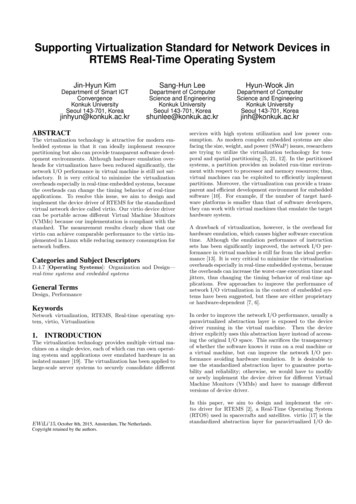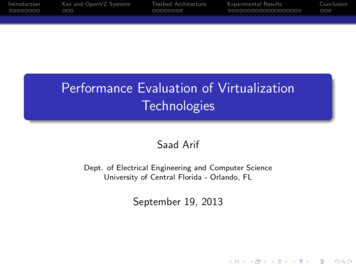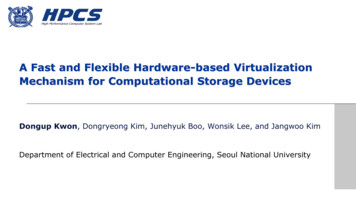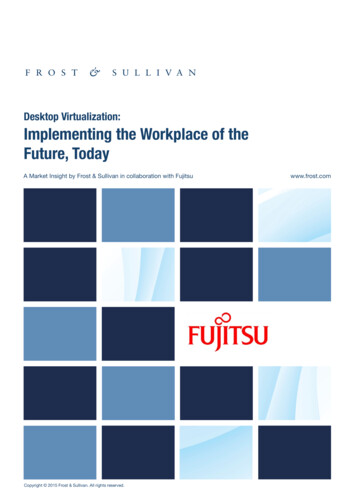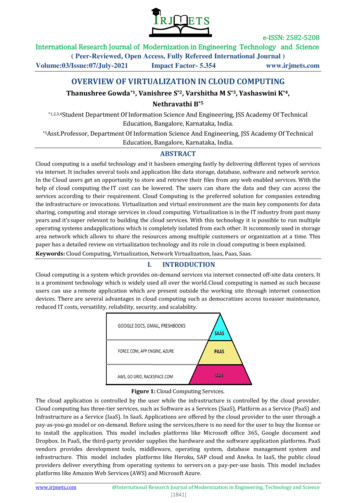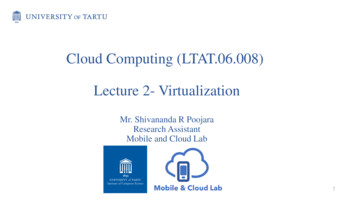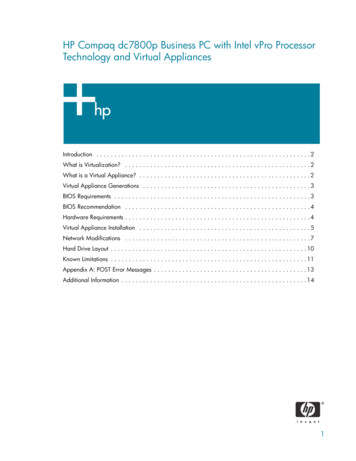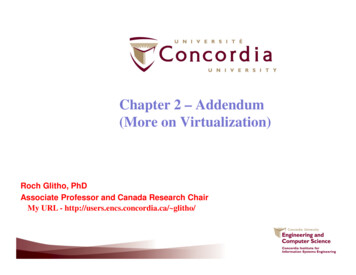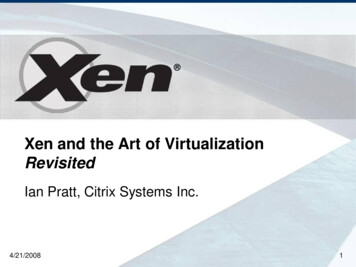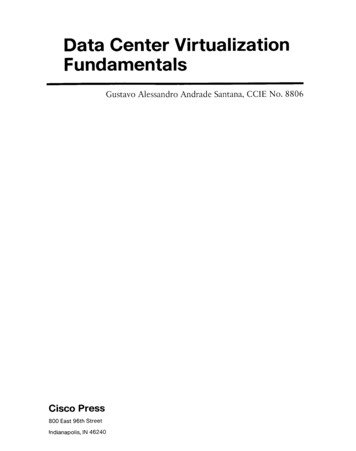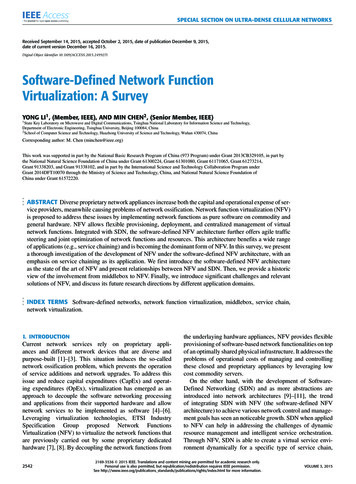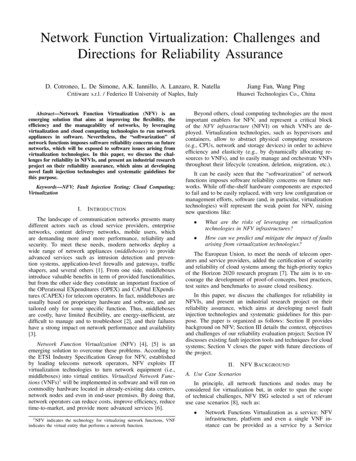
Transcription
Network Function Virtualization: Challenges andDirections for Reliability AssuranceD. Cotroneo, L. De Simone, A.K. Iannillo, A. Lanzaro, R. NatellaJiang Fan, Wang PingCritiware s.r.l. / Federico II University of Naples, ItalyHuawei Technologies Co., ChinaAbstract—Network Function Virtualization (NFV) is anemerging solution that aims at improving the flexibility, theefficiency and the manageability of networks, by leveragingvirtualization and cloud computing technologies to run networkappliances in software. Nevertheless, the “softwarization” ofnetwork functions imposes software reliability concerns on futurenetworks, which will be exposed to software issues arising fromvirtualization technologies. In this paper, we discuss the challenges for reliability in NFVIs, and present an industrial researchproject on their reliability assurance, which aims at developingnovel fault injection technologies and systematic guidelines forthis purpose.Keywords—NFV; Fault Injection Testing; Cloud Computing;VirtualizationI.I NTRODUCTIONThe landscape of communication networks presents manydifferent actors such as cloud service providers, enterprisenetworks, content delivery networks, mobile users, whichare demanding more and more performance, reliability andsecurity. To meet these needs, modern networks deploy awide range of network appliances (middleboxes) to provideadvanced services such as intrusion detection and prevention systems, application-level firewalls and gateways, trafficshapers, and several others [1]. From one side, middleboxesintroduce valuable benefits in term of provided functionalities,but from the other side they constitute an important fraction ofthe OPerational EXpenditures (OPEX) and CAPital EXpenditures (CAPEX) for telecom operators. In fact, middleboxes areusually based on proprietary hardware and software, and aretailored only for some specific function. Thus, middleboxesare costly, have limited flexibility, are energy-inefficient, aredifficult to manage and to troubleshoot [2], and their failureshave a strong impact on network performance and availability[3].Network Function Virtualization (NFV) [4], [5] is anemerging solution to overcome these problems. According tothe ETSI Industry Specification Group for NFV, establishedby leading telecoms network operators, NFV exploits ITvirtualization technologies to turn network equipment (i.e.,middleboxes) into virtual entities. Virtualized Network Functions (VNFs)1 will be implemented in software and will run oncommodity hardware located in already-existing data centers,network nodes and even in end-user premises. By doing that,network operators can reduce costs, improve efficiency, reducetime-to-market, and provide more advanced services [6].1 NFVindicates the technology for virtualizing network functions, VNFindicates the virtual entity that performs a network function.Beyond others, cloud computing technologies are the mostimportant enablers for NFV, and represent a critical blockof the NFV infrastructure (NFVI) on which VNFs are deployed. Virtualization technologies, such as hypervisors andcontainers, allow to abstract physical computing resources(e.g., CPUs, network and storage devices) in order to achieveefficiency and elasticity (e.g., by dynamically allocating resources to VNFs), and to easily manage and orchestrate VNFsthroughout their lifecycle (creation, deletion, migration, etc.).It can be easily seen that the “softwarization” of networkfunctions imposes software reliability concerns on future networks. While off-the-shelf hardware components are expectedto fail and to be easily replaced, with very low configuration ormanagement efforts, software (and, in particular, virtualizationtechnologies) will represent the weak point for NFV, raisingnew questions like: What are the risks of leveraging on virtualizationtechnologies in NFV infrastructures? How can we predict and mitigate the impact of faultsarising from virtualization technologies?The European Union, to meet the needs of telecom operators and service providers, added the certification of securityand reliability of cloud systems among the high-priority topicsof the Horizon 2020 research program [7]. The aim is to encourage the development of proof-of-concepts, best practices,test suites and benchmarks to assure cloud resiliency.In this paper, we discuss the challenges for reliability inNFVIs, and present an industrial research project on theirreliability assurance, which aims at developing novel faultinjection technologies and systematic guidelines for this purpose. The paper is organized as follows: Section II providesbackground on NFV; Section III details the context, objectivesand challenges of our reliability evaluation project; Section IVdiscusses existing fault injection tools and techniques for cloudsystems; Section V closes the paper with future directions ofthe project.II.NFV BACKGROUNDA. Use Case ScenariosIn principle, all network functions and nodes may beconsidered for virtualization but, in order to span the scopeof technical challenges, NFV ISG selected a set of relevantuse case scenarios [8], such as: Network Functions Virtualization as a service: NFVinfrastructure, platform and even a single VNF instance can be provided as a service by a Service
KeyVirtual DeepPacketInspectionVNFVirtual FirewallEnd PointVMData Cen treCommod ity HardwareVirtual AccessRouterVirtual WANOptimizationControllerVirtual IntrusionPreventionSystemVirtual WANOptimizationControllerVirtual AccessRouterFig. 1.Virtual FirewallVirtual DeepPacket InspectionVirtual IntrusionPrevention System Virtualization of Mobile Core Network and IMS: themobile networks and the IP Multimedia Subsystemsare populated with a large variety of proprietary hardware appliances, which costs and complexity can bereduced introducing NFV; Virtualization of Mobile base station: mobile operatorscan apply NFV in order to reduce costs as well ascontinuously develop and provide better service totheir customer; Virtualization of the Home Environment: Installationof new equipment can be avoided in the home environment with the introduction of VNFs, reducingmaintenance and improving service provision; Virtualization of CDNs: Content Delivery Networksuse cache node to improve the quality of multimediaservices, but it comes with lots of disadvantages (e.g.,waste of dedicated resources) that could be mitigatedby NFV;Fixed Access Network Functions Virtualization: virtualization supports multiple tenancy in access networkequipment, whereby more than one organizationalentity can either be allocated, or given direct controlof, a dedicated partition of a virtual access node.In all the scenarios, service providers run VNF instancesinside an NFV Infrastructure (NFVI)2 . It provides the capability or functionality of an environment in which both virtualized2 AsVirtual AccessRouterVNF-FG scenarioProvider, based on models similar to the cloud computing service models [9]; Virtual FirewallMANAGEMENT AND ORCHESTRATIONVIRTUALIZATION LAYERmentioned before, a NFV is the technology for making a networkfunction virtual, namely a VNF. The NFVI, instead, represents the environmentin which more than one VNF may execute.and non-virtualized network functions can be connected intoa service chain, i.e. VNF Forwarding Graph (VNF-FG)[8].The NFVI includes common elements of cloud computingsuch as physical computing, network and storage resourcesand resource pooling mechanisms. Fig. 1 shows an exampleof a VNF-FG commonly encountered where packet traversea VNF implementation of a router, a Deep Packet Inspectionand a Firewall, with the possibility of adding to the service anInstruction Prevention System or a WAN Optimization Controller. Every VNF is mapped through the virtualization layerto a pool of VMs. Each VNF could be replicated on severalVMs and placed on different hardware or even sites, while theManagement and Orchestration (M&O) component decideswhich VNF instance a specific request should be forwardedto.B. The NFVI ArchitectureThe NFV ISG is defining a potential architecture of theNFVI, to support the deployment and execution of VNFs [10].The NFVI is part of a framework whose architecture isdepicted in Fig. 2. The NFVI Domain includes the threeprimary domains of the NFVI, i.e.: Compute (and Storage) Domain: it provides theCOTS computational and storage resources; Hypervisor Domain: it mediates the resources ofthe compute domain to the VMs of the softwareappliances providing an abstraction of the hardware; Infrastructure Network Domain: it provides severalcommunication channels between entities of all thedomains and it is the mean of remote deployment ofVNFs.
CarrierManagementNFV Application DomainExisting NetworkNFVI Container InterfaceManagementandOrchestrationDomainVirtual NetworkContainer InterfaceInfrastructureNetwork DomainVirtual Machine Container InterfaceHypervisor DomainCompute Container InterfaceCompute DomainFig. 2.NFV framework and associated interfacesMoreover, the framework comprises the NVF ApplicationDomain that hosts VNFs, and the M&O Domain that controlsand manages software appliances running on the infrastructure.The inter-domain communication requires a container interface which is the environment within a host function isconfigured and/or programmed in order to provide a virtualizedfunction. The identified inter-domain interfaces are: NFVI Container Interfaces: it is provided by theinfrastructure to host VNFs. The applications maybe distributed and the infrastructure provides virtualconnectivity which interconnects the distributed components of an application.Virtual Network Container Interface: the interfaceto the connectivity services, provided by the infrastructure. This container interface makes the infrastructure appear to the NFV applications as instances ofthese connectivity services. Virtual Machine Container Interface: it is the primary hosting interface on which the VMs run. Compute Container Interface: it is the primarycompute hosting interface on which the hypervisorruns.C. Reliability RequirementsNFV ISG has identified manifold requirements, includingrequirements on resiliency of VNFs [11], [12]. Telecom Operators are concerned by the availability of their products and theuser-perceived dependability because (1) unreliable servicesare likely to be discarded by users and (2) the total costs ofsystem failures can be tremendous. Potential causes of VNFfailures are: Hardware Faults: the use of COTS servers is a sourceof faults in the NFVI, that may negatively affect theVNFs running on them; Software Faults: at various levels, such as host OS,hypervisor, VM, or the VNF instance itself;Operator Faults: mistaken operations and configuration, e.g. capacity planning, VM deployment andmigration.The NFV framework should be able to achieve resiliencyin spite of these faults. NFV requirements will focus primarilyon specific aspects introduced by NFV, and not on aspects ofthe network functions interfaces, protocols and managementthat are identical whether the implementation is physical orvirtual.The NFV framework needs to provide the necessarymechanisms to allow VNFs to be recovered after a failure.Fault-tolerance mechanisms, such as VNF redundancy, faultisolation, recovery after a failure and transparency, shouldguarantee the required service continuity. The NFV M&Ocomponent should be responsible for controlling these andother mechanisms, thus it is vital that it does not become asingle point of failure. Above all, the NFV framework shallprovide the necessary mechanisms to achieve the same level ofservice availability for fully and partially virtualized scenariosas for existing non-virtualized networks.III.R ELIABILITY E VALUATION P ROJECTOur project aims to give Telecom Operators the opportunityto evaluate the reliability of an NFVI. In order to achievethis, we focus on two complementary tasks. On one hand,we will produce techniques and tools for reliability evaluationof NFVI. On the other, we will formulate methodologies andguide lines for practitioners to use these techniques and toolsproperly and with valuable results.NFVI implementations will exploit the off-the-shelf products already present in the cloud-computing market, so NFVIreliability depends strictly on the reliability these products canprovide. The virtualization technologies we will consider asactual enablers for NFVI are: VMware vSphere [13], a family of mature commercial products for the whole life-cycle managementof hypervisor-based VMs, including high-availabilitymechanisms; Linux Containers [14], an emerging open-sourceproject that enhances the Linux kernel, which runsguest applications in “containers”, by abstracting hardware and OS resources (e.g., CPU time, filesystems,network interfaces, etc.) and isolating them.In the context of business-critical scenarios, intense testingactivities are of paramount importance to guarantee that newsystems and their built-in fault-tolerance mechanisms are behaving as expected, and thus to assure a high level of reliability.Ensuring that the system behaves properly in the presenceof a fault is a problem that requires something more thantraditional testing. Fault Injection is the process of introducingdeliberately faults in a system, with the goal of assessing theimpact of faults on performance and on continuity of service,and the efficiency (i.e., coverage and latency) of its faulttolerant mechanisms.According to resiliency and service continuity requirementsof the NFV framework, as discussed in the previous sections,NFV should be able to provide mechanisms to allow network
functions to be recreated, and to assure a desired level ofperformance and of service continuity as mandated by SLAs.Fault Injection Testing is a systematic approach to assure, withquantitative evidence, that such requirements are satisfied.Cloud Management Stack (subsection IV-B), and Hypervisors(subsection IV-C).Considering the architecture of NFVIs, the application ofreliability evaluation approaches is not straightforward, sincethere are several challenges that make the NFVI reliabilityevaluation tool harder to design, and that will be taken intoaccount. Within these challenges, the most influential are listedbelow:D-Cloud [16] is a dedicated simulated test environment,based on QEMU for virtualizing physical machines, and onEucalyptus cloud computing system for managing these VMs.D-Cloud adopts QEMU to emulate hardware faults, by injecting various typical faults into the guest OS. Black-box and complex nature of virtualizationtechnologies: the testing and the reliability evaluationof NFVIs should be performed considering the lackof information about internal structure, design andimplementation of virtualization technologies, that areoften provided by third parties (e.g., VMware); Lack of well-established reliability evaluation criteria for NFVIs: since NFV is a technology still underactive development, it is not clear how the reliability ofNFVIs should be evaluated and, thus, proper measuresand metrics should be identified. Integration and interoperability: the integration andthe interoperability among COTS hardware and software components increase the complexity of the infrastructure, and thus the set of faults we have to facewith;IV.FAULT I NJECTION IN C LOUD C OMPUTINGAs mentioned in the introduction, the NFV world isstrictly related to cloud computing technologies. Thus, basedon everything-as-a-service (XaaS) delivery model, a cloudprovider can develop Internet services, from security anddatabases to storage and integration, no longer require leverageon expensive specific-purpose hardware and on big initialcapital costs.Virtualization is an enabling technology to set up a cloudcomputing infrastructure. Virtualization allows to abstractphysical resources (e.g., CPUs, network devices, storage devices, etc.) in order to share and to provide resources, makinga physical machine as a soft component to use and managevery easily. Virtualization software is used to run one or moreso-called Virtual Machines (VMs) (a software abstraction of aphysical machine) on a single physical machine, providing thesame functionalities as if they were more physical machines.This virtualization software is named Hypervisor, which isresponsible of executing and managing multiple VMs in orderto synchronize the access to the CPU, memory and other I/Oresources of the physical machine.Therefore, to assure the reliability of cloud systems, it isnecessary to assess the reliability of the virtualization environment as a whole, focusing both on VMs and on the Hypervisor,as well as on the Cloud Management Stack software thatorchestrates them (such as the well-known OpenStack framework [15]) to efficiently manage cloud infrastructures. In thissection, we present an overview of related studies that adoptfault injection to assure a high-level of reliability of cloudsystems, focusing on Virtual Machines (subsection IV-A),A. Fault Injection Testing of Virtual MachineDS-Bench Toolset [17] is a framework (it includes DCloud) that computes dependability metrics of the overall system under test (SUT), using various benchmark programs, byinjecting anomaly loads; furthermore, it provides the evidencefor the assurance case based on the benchmark results.D-Cloud considers hardware faults in memory, hard-diskand network devices. It performs fault injection by simulatingdata corruptions in the emulated devices. The fault typesinclude the corruption of individual sectors of the disk (e.g.,the sector was damaged by head crash), of packets sent throughthe network (e.g., loss or bit corruption of a packet), and ofmemory cells. Moreover, it can simulate an unresponsive orslow hard disk and network devices.B. Fault Injection Testing of Cloud Management StackA systematic study on fault resilience of OpenStack [15]is reported in [18]. Openstack is one of the most importantopen cloud computing software, that controls compute, storageand networking resources in a whole data center, managedand provisioned through a web-based dashboard, commandline tools or a RESTful API. The proposed framework injectsnetwork faults targeting communications among OpenStack’sservices like compute, image and identity services, but alsodatabase, hypervisor and messaging services. The authorsevaluate the framework on two OpenStack versions, identifyingbugs, such as timeout between services communication, or lackin period checking of service liveness (VM creation API hascompleted its job?) and so on, more described in the nextsections.PreFail [19] allows to deal with a very high numberof injection experiments, that arises from the ”combinatorialexplosion” of multiple injections. The PreFail tool allowsthe tester to control fault injection using pruning policies,which select the combinations of faults to be injected duringexperiments. The policies offered by PreFail are orientedtowards selecting a small set of faults, and to maximize theefficiency of fault injection tests. This goal is reached by lettingthe user to specify a pruning policy.Netflix [20] is developing the The Simian Army [21], aset of tools (named monkeys) that allows to inject faults into acloud computing platform, specifically built within AWS [22].Simian Army’s ”monkeys” for assessing resiliency are manifoldand they allow to: randomly terminate virtual instances (i.e., virtual machines) in the production environment (Chaos Monkey); cause an entire data center (e.g., an Amazon availability zone (AZ)) to go down (Chaos Gorilla);
bring down an entire region, made up of multiple datacenters (Chaos Kong); inject faults that simulate partially healthy instances(Latency Monkey).requires additional effort to analyze the internals ofthe virtualization layer and to instrument it. Currently, Netflix developed only the Chaos Monkey [23]and their related fault types. Fault injection is performed byexecuting a script that simulates a specific type of fault.C. Fault Injection Testing of HypervisorCloudVal [24] is a framework to test the reliability of hypervisor within a cloud infrastructure. The framework providesan injector (implemented using debugger-based techniques)that allows to inject different type of faults like transient (soft)faults, guest misbehavior, performance faults and maintenancefaults. This work is a starting point to develop a benchmarkfor validating cloud virtualization infrastructures.V. Failure Mode and Effects Analysis of virtualization technologies in NFVIs: we need to analyze thearchitecture of NFVI and its potential threats in orderto understand what can affect reliability. The FMEAshould consider not only hardware failures, but alsofailures due to software and configuration faults thatcan impact on virtualized resources (e.g., virtual CPU,memory, network and storage); Definition of Key Performance Indicators andMethodologies for NFVI reliability: we will definemeasures for fault tolerance and performance, andprovide guidelines to allow reliability engineers tosystematically assess reliability by means of faultinjection testing; Design of novel Fault Injection Techniques: becauseof the challenges in NFVIs (e.g., black-box technologies), the most advantageous injection target seemsto be represented by the interfaces of the Compute,Hypervisor and Network domains. The errors andcorruptions to be injected should be defined on thebasis of the FMEA; Validation using NFV products and technologies:we will conduct a proof-of-concept validation of thefault injection approach on commercial NFV products,based on virtualization technologies mentioned in thepaper (i.e., VMWare and LXC).Table I shows a comparison between fault injection approaches and the related tools mentioned above.D. DiscussionConcerning the reliability of cloud telecom networks, thetools overviewed in this paper can be applied only to alimited extent of NFVIs since they are not designed withNFV scenarios in mind. We have identified the followinglimitations of existing tools, and that will need to be tackledin the development of a new Fault Injection Tool for NFVIsas mentioned in the Section III: Injection of Software and Configuration faults. Sofar, fault injection testing tool in cloud computingsystems has mostly been focused on the injection ofhardware faults (e.g. affecting CPU, memory, networkand disk) to assess the tolerance and robustness ofcloud systems to these faults. However, in an NFVI,the use of third-party software components, such asCOTS virtualization technologies (e.g., VMware, Xen)and cloud management software (e.g., Openstack), exacerbates the overall complexity. Therefore, softwareand configuration faults must be included in faultinjection testing, in order to predict and mitigate theimpact of such faults on NFVI.Black box virtualization technologies. The surveyedtools focused on open-source virtualization technologies, such as the Xen and KVM hypervisors andthe OpenStack cloud management platform. Unfortunately, performing the same on commercial off-theshelf software (e.g., VMware, very popular in thevirtualization panorama) is much more difficult, andC ONCLUSION AND FUTURE DIRECTIONSIn this paper, we presented an ongoing industrial researchproject, that aims at investigating how to assess the risksintroduced by virtualization technologies for NFVI reliability.Towards this goal, we plan to conduct the following activities:The CloudVal framework supports fault injection in theKVM and Xen, both on the guest and host domains, and on thecore modules of the hypervisors (i.e., qemu-kvm and the KVMkernel module for KVM [25]; qemu-dm and xenstored for Xen[26]). The tests are performed to evaluate VMs guest/hostisolation and correlated hypervisor behavior, and the levelof maintainability. Finally, Virt-manager [27] (a libvirt-basedmanagement system) is used by CloudVal for monitoring andmanaging a system during fault injection experiments. Testing scenarios for NFVIs. NFV is a technology that is still under active development. Thus, abig challenge is to develop proof-of-concepts thatcould demonstrate how, in practice, Fault Injectioncan be applied to obtain useful measures for theNFVI architect, such as measures for benchmarkingalternative components and designs for an NFVI underdevelopment.R EFERENCES[1][2][3][4][5]V. Sekar, S. Ratnasamy, M. K. Reiter, N. Egi, and G. Shi, “Themiddlebox manifesto: Enabling innovation in middlebox deployment,”in Proc. Wksp. HotNets-X, 2011, pp. 1–6.J. Sherry, S. Hasan, C. Scott, A. Krishnamurthy, S. Ratnasamy, andV. Sekar, “Making middleboxes someone else’s problem,” in Proc.SIGCOMM, 2012, pp. 13–24.Chandler Harris. Data Center Outages Generate Big Losses. -generate-big-losses/d/d-id/1097712.NFV ISG, “Network Functions Virtualisation - An Introduction,Benefits, Enablers, Challenges & Call for Action,” ETSI, Tech. Rep.,2012. [Online]. Available: http://portal.etsi.org/NFV/NFV\ White\Paper.pdf——, “Network Functions Virtualisation (NFV) - Network OperatorPerspectives on Industry Progress,” Tech. Rep., 2013. [Online].Available: http://portal.etsi.org/NFV/NFV\ White\ Paper2.pdf
TABLE I.C OMPARISON OF FAULT INJECTION APPROACHES .ApproachToolTargetFaultloadFault Injection Testing ofVirtual MachinesD-Cloud [16] andDS-Bench Toolset [17]Server software (e.g.,web applications)Network, disk, memoryfaultsChaos Monkey [23]Virtual instances duringruntimeCPU, disk, networkExecuting scripts thatsimulates a fault ontarget machinePreFail [19]Distributed filesystemsand algorithms (e.g.,HDFS, ZooKeeper)Network and disk faults;Process crashesAPI exception injectionOpenstack resilienceframework [18]OpenStackCloudVal [24]Hypervisors (e.g., Xen,KVM)Fault Injection Testing ofCloud ManagementSoftwareFault Injection Testing . Manzalini, R. Minerva, E. Kaempfer, F. Callegari, A. Campi,W. Cerroni, N. Crespi, E. Dekel, Y. Tock, W. Tavernier et al., “Manifestoof edge ICT fabric,” in Proc. ICIN, 2013, pp. 9–15.European Union Agency for Network and Information Security,“Cloud computing certification.” [Online]. Available: -certificationNFV ISG, “Network Function Virtualisation (NFV) - Use Cases,”Tech. Rep., 2013. [Online]. Available: http://www.etsi.org/deliver/etsi\gs/NFV/001\ 099/001/01.01.01\ 60/gs\ NFV001v010101p.pdfP. Mell and T. Grance, “The nist definition of cloud computing,” tructure Architecture - Overview,” Tech. Rep., 2014. [Online]. Available: http://docbox.etsi.org/ISG/NFV/Open/Latest\ �—, “Network Functions Virtualisation (NFV) - Virtualisation Requirements,” Tech. Rep., 2013. [Online]. Available:http://www.etsi.org/deliver/etsi\ gs/NFV/001\ 099/004/01.01.01\ 60/gs\ isation(NFV)Resiliency Requirements,” ETSI, Tech. Rep., 2014. [Online]. Available: http://docbox.etsi.org/ISG/NFV/Open/Latest fVMWare Inc., “Vmware virtualization for desktop & server,application, public & hybrid clouds — united states.” [Online].Available: http://www.vmware.com/D. Lezcano, S. Hallyn, and S. Graber, “LXC - Linux Containers:Userspace tools for the Linux kernel containers.” [Online]. Available:https://linuxcontainers.org/Openstack, “Openstack.” [Online]. Available: http://www.openstack.org/Service crash andNetwork partitionCPU, memory, 6][27]Injection techniqueEmulation of faultydevices; VM memorycorruptionAPI exception injectionMemory corruptionExamples of resultsValidation ofperformance levels underfaultsTerminates over 65,000instances running inNetflix production andtesting environments,detecting many failurescenariosRobustness of recoveryprotocolsImprovement ofrobustnessImprovement of VMisolationT. Banzai, H. Koizumi, R. Kanbayashi, T. Imada, T. Hanawa, andM. Sato, “D-cloud: Design of a software testing environment for reliabledistributed systems using cloud computing technology,” in Proc. Intl.Conf. CCGRID, 2010, pp. 631–636.H. Fujita, Y. Matsuno, T. Hanawa, M. Sato, S. Kato, and Y. Ishikawa,“DS-Bench Toolset: Tools for dependability benchmarking with simulation and assurance,” in Proc. Intl. Conf. DSN, 2012, pp. 1–8.X. Ju, L. Soares, K. G. Shin, K. D. Ryu, and D. Da Silva, “On faultresilience of OpenStack,” in Proc. SoCC, 2013, pp. 1–16.P. Joshi, H. S. Gunawi, and K. Sen, “Prefail: A programmable toolfor multiple-failure injection,” in Proc. Intl. Conf. OOPSLA, 2011, pp.171–188.Netflix, “Netflix Home Page.” [Online]. Available: https://www.netflix.comA. Tseitlin, “The antifragile organization,” Commun. ACM, vol. 56,no. 8, pp. 40–44, Aug. 2013.Amazon.com, Inc., “Amazon web services homepage.” [Online].Available: http://aws.amazon.com/Netflix, “The Chaos Monkey.” [Online]. Available: onkeyC. Pham, D. Chen, Z. Kalbarczyk, and R. K. Iyer, “CloudVal: Aframework for validation of virtualization environment in cloud infrastructure,” in Proc. Intl. Conf. DSN, 2011, pp. 189–196.A. Kivity, Y. Kamay, D. Laor, U. Lublin, and A. Liguori, “kvm: thelinux virtual machine monitor,” in Proc. Linux Symp., vol. 1, 2007, pp.225–230.P. Barham, B. Dragovic, K. Fraser, S. Hand, T. Harris, A. Ho, R. Neugebauer, I. Pratt, and A. Warfield, “Xen and the art of virtualization,” inProc. SOSP, 2003, pp. 164–177.RedHat. Virt-manager. http://virt-manager.et.redhat.com/.
network functions imposes software reliability concerns on future networks, which will be exposed to software issues arising from virtualization technologies. In this paper, we discuss the chal- lenges for reliability in NFVIs, and present an industrial research project on their reliability assurance, which aims at developing novel fault injection technologies and systematic guidelines for .
